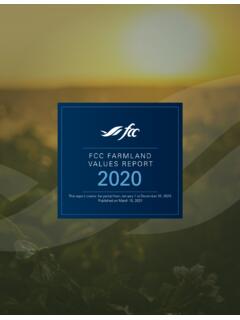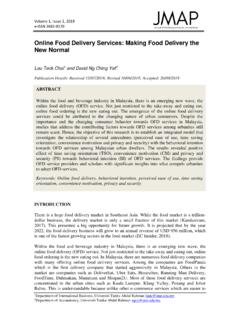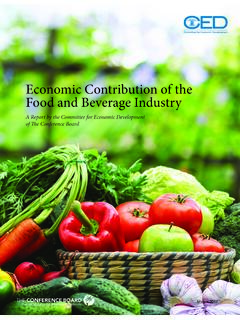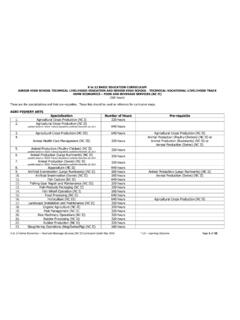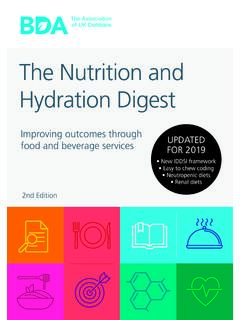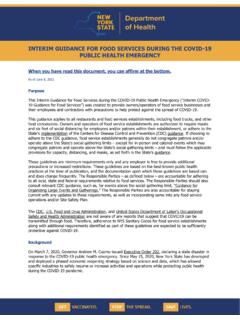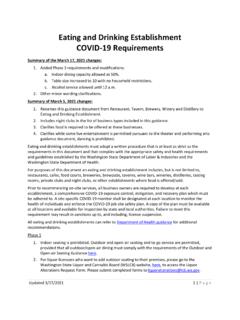Transcription of FCC Food and Beverage Report 2021
1 FCC food AND Beverage Report 2021 A Published on March 30, 2021 FCC food AND Beverage REPORT2021 FCC food AND Beverage Report 2021 B 1 Summary3 Grain and oilseed milling5 Sugar and confectionery products7 Fruit, vegetable and specialty food9 Dairy products11 Meat products13 Seafood preparation15 Bakery and tortilla products17 BeveragesContentsFCC food AND Beverage Report 2021 1 SUMMARYGet ready, set, growThe onset of COVID-19 was a shock to many industries as governments worldwide closed portions of their economy, and more people began working from home. Closing foodservices caused significant disruptions to the food supply chain, as manufacturers were forced to re-evaluate their current business strategies and move production away from foodservice to the grocery store.
2 New concerns over employee health forced companies to make significant investments in personal protective equipment (PPE) and adjustment to procedures. The sector showed tremendous resilience. Gradual re-opening of economies created new opportunities and challenges as consumer behaviours were continually shifting, forcing food manufacturers to remain agile. food and Beverage manufacturing sales increased year-over-year (YoY) in 2020 from $ billion to $ billion. Sales declines from the foodservice industry were offset by increases in domestic grocery store sales and growing exports. GDP fell from lower investment and higher costs. The share of the food and Beverage manufacturing sectors in the overall Canadian economy grew by to (Figure 1) as other industries like air transportation, oil extraction and accommodation services recorded a decline.
3 food and Beverage manufacturing exports grew by , driven by strong demand for healthy and high-quality foods, a weak Canadian dollar in the spring, and higher prices in the fourth quarter. Strong export demand will be a big part of the 2021 growth story. Export growth in 2020 came mostly from the and China. Total food and Beverage imports grew by in 2020 YoY as a diversified portfolio of countries increased exports to Canada (Figure 2). Net income before taxes as a per cent of sales in food and Beverage manufacturing was higher in 2020, rebounding from a net loss in Q2 to in Q4. Margins were squeezed by increases in wages, PPE costs, cost reduction measures from retailers and higher commodity prices. Consumers focusing on basic needs and bulking up on larger-sized products meant selling lower margin items as well.
4 Higher margins made on frequent impulse and convenience items declined with social the pandemic has brought losses that can never be recouped, opportunities are being presented for Canada s food and Beverage industries to thrive. In many ways, the pandemic did not create these opportunities but accelerated the underlying trends that promote them. These include consumer demands for local, convenient, healthy and sustainable foods. Challenges for the industries include a global movement toward nationalism and domestic productivity challenges. By some measures, 2020 productivity per employee in food and Beverage manufacturing is 22% higher in the versus Canada. serviceRetailWholesaleFBT processingPrimary agInput and service suppliers5-year average20207.
5 57. supply chain percent of GDPS ource: Statistics Canada and FCC calculationsFigure 1: food and beverages manufacturing became a larger part of the economy in 202002,0004,0006,0008,00010,00012,00014, 00016, trade balance by region, $ millionsSource: Statistics Canada and FCC calculationsFigure 2: food and Beverage trade surplus driven by the food AND Beverage Report 2021 2 The Canadian federal and provincial governments have identified food processing as a key contributor to our economic recovery. The focus of government investment is to increase food autonomy and focus on safe plant output. This investment, along with very low interest rates, could be the catalyst the sector needs to solve a productivity economic indicators in the food and Beverage industries are strong relative to the broad economy (tables 1 and 2), showcasing its resilience.
6 Capital expenditures and employment in food and Beverage fell less in percentage terms versus all industries combined. The all-item CPI inflation in 2020 was (Table 2) compared to food projects sales to increase to $ billionIncreases in disposable income and savings in 2020 will be supportive of growth in food consumption. Margin growth will depend on several factors, the biggest being the evolution of the COVID pandemic. A successful vaccine rollout would alleviate some PPE related costs and allow the full re-opening of foodservices. Global economic health is also important because exports represented an estimated of food and Beverage sales over the previous five years. Table 1: Manufacturing sales and exports grew in 2020 YoYFood and Beverage sales facts ($ millions)2020 YoY% change2019 YoY% changeManufacturing sales122, , , , , , balance4,0997.
7 03, food and Beverage store retail sales14 3 ,10 ,5 foodservice retail sales55, 7, 0 2 food establishment retail sales198, , : Statistics CanadaTable 2: Most economic indicators pointed downward in 2020 Economic indicators2020 YoY% change2019 YoY% changeAll industries GDP ($ millions 2012 dollars)1,875, ,980, and Beverage GDP ($ millions 2012 dollars)33, , expenditure ($ millions)242, 6 7, 97 and Beverage capital expenditure ($ millions)4 ,18 , CPI13 7. rate7. employment all industries17,999, ,985, and Beverage employment140,458- 3 .114 4, income345, , debt50, ,6 : Statistics Canada and FCC calculationsFCC food AND Beverage Report 2021 3 GRAIN AND OILSEED MILLINGI ntroductionDeclines in foodservice demand and higher input costs created profitability challenges for grain and oilseed millers.
8 Higher selling prices and the re-opening of global foodservice are expected to support a potentially exceptional 2021. Reductions in foodservice revenue resulted in sales declining in 2020 YoY (Table ). Demand for flour and other baking products increased at the onset of the pandemic, partially offsetting foodservice declines but waned through the year as cooking fatigue set in. Labour productivity and wages compounded profitability challenges in 2020. Businesses struggled to shift production from foodservice to retail resulting in overtime and higher wages. On top of that, social distancing and sanitation rules slowed production resulting in sales per employee declining YoY. The net result was wages as a percent of sales increasing to GDP declined due to weaker sales and higher input costs.
9 A return to pre-COVID production should normalize labour costs and productivity in : Sales per employee fell from higher wages and total employment Grain and oilseed milling (NAICS 3112) quick facts2020 YoY% change2019 YoY% changeSales ($ millions)10, , ($ millions)8, , 5 5 ($ millions)4, , balance ($ millions)3, , number of jobs 8,71513 .17,70 average hourly % of per employee1,174, , 3 7 7, 9 6 2,191-11. 52, : Statistics CanadaSales forecastFCC projects sales to increase in 2021. This would result in sales higher compared to 2019 (Figure ). The re-opening of foodservices will support strong demand for grains and vegetable fats, and growing demand for plant-based proteins will boost protein processing. The second and third quarters are projected to see the strongest YoY increases because of weak sales and relatively lower prices in those quarters during 2020.
10 Swings in the Canadian dollar and the health of the economy can drastically impact these projections, with the value of exports representing of total sales over the past five years. Annual manufacturing forecast, $ millionsyear-over-year percent changeSource: Statistics Canada, Quandl and FCC calculations02,0004,0006,0008,00010,0001 2,00014, : Grain and oilseed milling sales expected to increase in 2021 YoYFCC food AND Beverage Report 2021 4 International tradeStrong Chinese grain demand lifted prices during the winter of 2020-21. This could be just what the industry needs to get through one of the worst years in recent memory. The , China, South Korea and Japan are large importers of Canadian grain and oilseed milling products.
